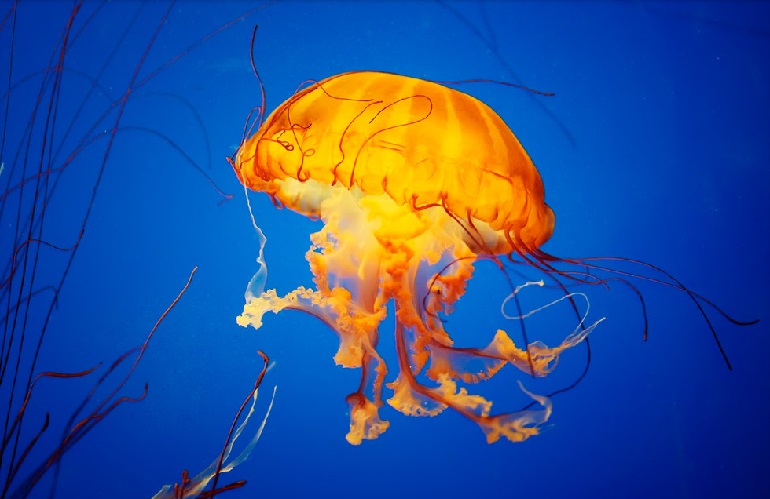Overview
Did you know that a group of jellyfish is sometimes called a smack? I reckon you’ll agree that nickname is appropriate if you’ve ever swum right into one of these animals and been stung by its trailing tentacles!
These remarkable animals have been around since before the dinosaurs lived, which is pretty impressive for what’s essentially just a floating bag of water. And today, the 4,000 known species of humble jellyfish are an essential part of the ocean’s ecosystem.
Read this guide to discover more about these simple yet complicated animals.
Evolution

Jellyfish are ancient creatures that have existed in the earth’s oceans for millennia.
Although jellyfish are generally associated with saltwater habitats, there are some species that live in freshwater environments. For example, the Peach Blossom fish or Craspedacusta sowerbyi is indigenous to the Yangtze River in China.
Fossil History
Today’s jellies’ oldest ancestors were around at least 500 or even 700 million years ago. Incredibly, that makes jellyfish at least three times older than the very first dinosaurs!
Unfortunately, jellyfish fossils are extremely rare and hard to find, largely because these strange creatures don’t have skeletons or other hard body parts.
However, back in 2007, during a dig in Utah, scientists from the Smithsonian National Museum of Natural History found some incredibly well-preserved jellyfish fossils that dated back to 505 million years ago.
More well-preserved comb jelly fossils dating from around the same period were discovered in the Burgess Shale, a fossil-bearing deposit in Canada. As recently as 2019, some incredible Cambrian jellyfish fossils were discovered in southern China’s Quingjiang site.
Mapping To Taxonomic Groups
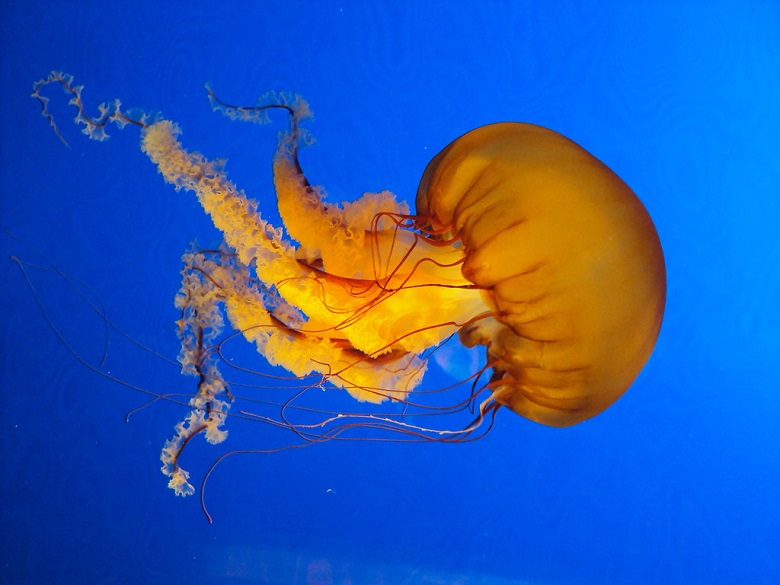
Sea jellies, sea nettles, and jellyfish are the informal names used for the Medusa life stage of some members of the subphylum Medusozoa, which forms a large part of the phylum Cnidaria.
It’s thought there are over 10,000 species of other Cnidarians, with around 4,000 of those making up Medusozoa, the group that contains all the animals commonly called jellyfish.
Classification and Scientific Name
Jellyfish have the scientific name Scyphozoa. Jellies are not fish and actually belong to the Kingdom Animalia like you and me.
There are four major classes of medusozoan Cnidaria:
Scyphozoa
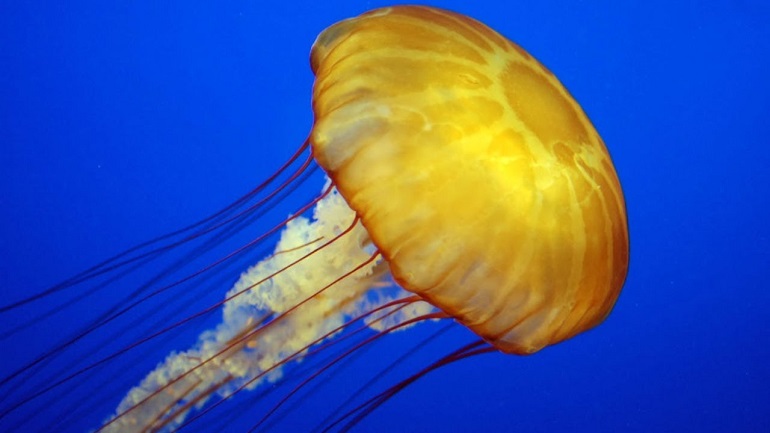
Scyphozoa are regarded as true jellyfish, with most species having a bell-shaped body surrounded by long tentacles. There are thought to be at least 200 species of true jellyfish, and they are the jellies that most of us have seen when swimming, washed up on our beaches.
Cubozoa
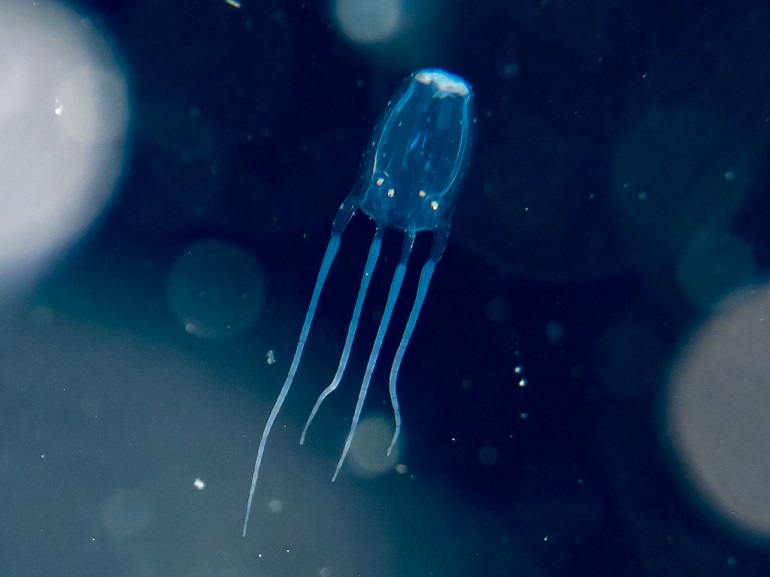
Cubozoa is box jellyfish, so named for its box-shaped bells. Some box jellies, such as the Sea Wasp, are one of the most poisonous creatures in our oceans.
Box jellyfish have a more advanced nervous system than true ones, which includes complex eyes with retinas, corneas, and lenses. Some species of box jellyfish are even known to indulge in complex courtship behaviors.
There are around 48 species of Cubozoa, living primarily in tropical waters.
Hydrozoa Medusae
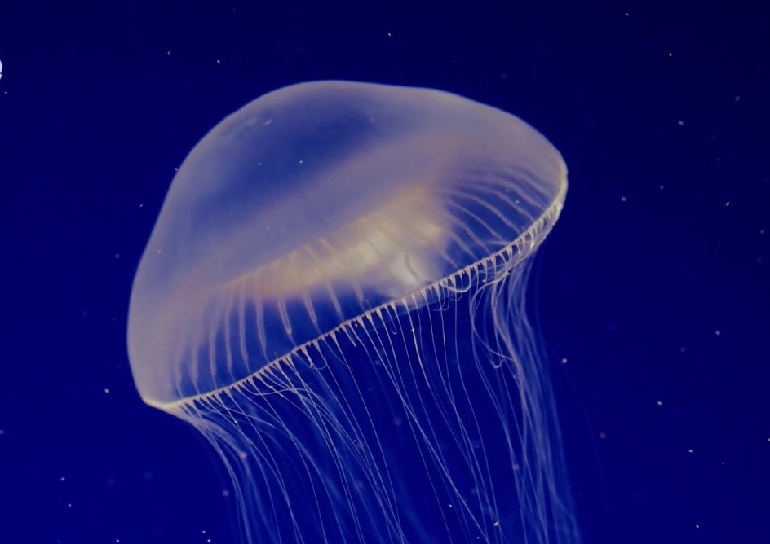
Hydrozoa is the largest group of jellies and includes around 3,800 species.
The medusa stage of these jellyfish is often tiny and easily overlooked, whereas the bottom-dwelling hydroids or polyps typically appear in huge colonies. Some Hydrozoan species don’t have a jellyfish stage, instead producing gametes in the hydroid or polyp stage.
New species of jellyfish are being discovered in the deep water habitats of the oceans. In 2016, a brand-new Hydrozoan species of Crossota was found living over 12,000 feet down within the Mariana Trench. Who knows what else is lurking in those unexplored depths?
Staurozoa
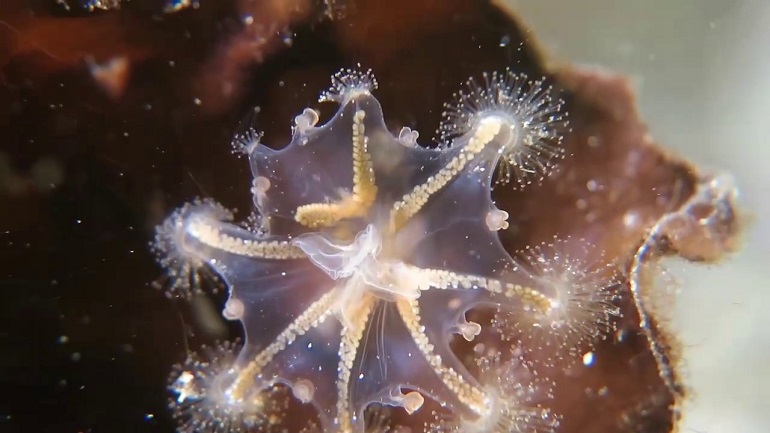
Staurozoa is stalked jellyfish that live in coldwater habitats. These trumpet-shaped, upside-down jellyfish don’t swim or float through the ocean like other jellyfish, preferring to live attached to a firm surface, such as seaweed or rocks.
There are thought to be about 50 species of stalked jellyfish, many of which are exceptionally beautiful.
Jellyfish Physical Characteristics
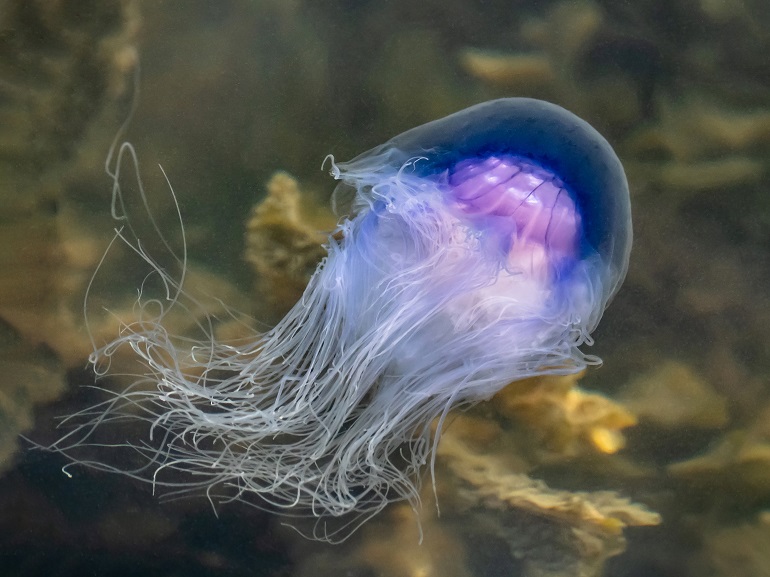
Jellyfish are around 95% water!
These animals don’t have a brain, stomach, intestines, or lungs. Instead, the jellyfish gets the oxygen and nutrients it needs to survive by absorbing them through its transparent skin.
Anatomy of Jellyfish
These simple creatures are composed of three layers:
- An outer layer called the epidermis
- A middle layer composed of a thick, elastic, jellyish substance called mesoglea
- An inner layer called the gastrodermis
The jellyfish can detect light, respond to external stimuli, and smell via a simple nervous system or nerve net.
The animal’s simple digestive cavity works as both a stomach and intestine and has two openings. One of those openings serves as both the jellyfish’s mouth and its anus. Amazing!
Largest and Smallest Jellyfish
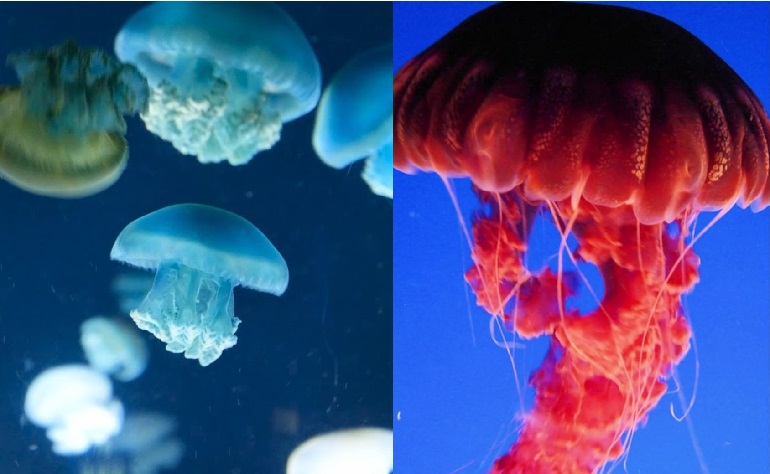
Jellyfish are incredibly diverse animals, coming in various shapes and sizes.
Most jellies range from under half an inch to around 16 inches wide. However, the smallest jellyfish are around one millimeter wide
Jellies Can Get As Big As Blue Whales!
The largest species of jellyfish is the Lion’s Mane or Cynea capillata, which can grow to reach over 6 feet in diameter with tentacles extending to over 100 feet long! That’s just about as big as a blue whale!
Jellyfish Tentacles
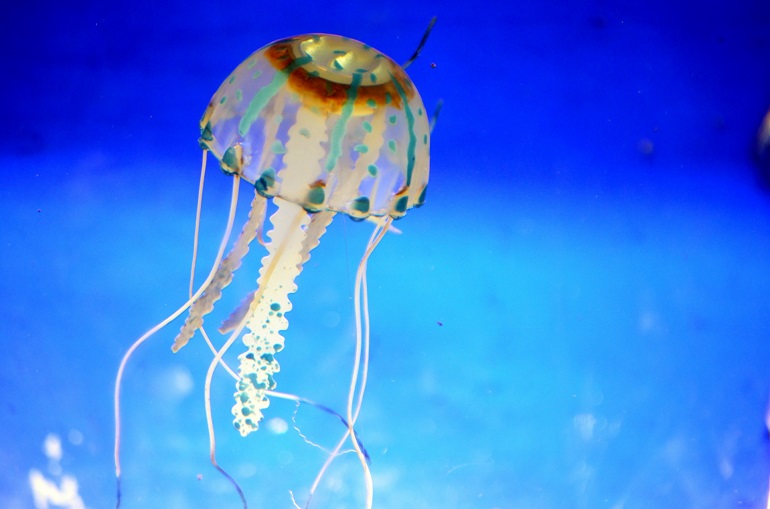
Jellyfish have tentacles covered with tiny stinging cells that they use to catch prey as they drift through the water column.
Some larger jellyfish species have tentacles reaching up to 10 feet long, which is why swimmers often fall foul of the jelly’s sting.
The Sting of the Jellyfish
Jellyfish and comb jelly have tentacles bearing special cells called nematocysts and colloblasts.
Jellyfish nematocysts sit within cells called cnidocytes, which contain venomous harpoon-like structures. When the cell is touched, the harpoon is activated, shooting out of the cell and into the prey or predator, where it releases its venom.
The whole process takes under 700 nanoseconds!
Comb jellies’ tentacles are lined with colloblasts. These work similarly to nematocysts but release a glue-like substance rather than venom. Once a prey item is stuck to the tentacles, the comb jelly reels it in and transfers the food to its mouth.
Deadly Jellyfish
Although jellyfish do not purposely attack humans, and most jellyfish stings occur as more of an irritation to swimmers than a real danger, box jellyfish stings are the exception to that. The most deadly jellyfish in the world is the box jellyfish, of which there are around 50 species.
Widely regarded as the most dangerous species to humans is the Sea Wasp or Chironex fleckeri. This almost invisible jelly is incredibly difficult to see and tends to hunt during shallow waters in the daytime, making it a deadly danger to swimmers enjoying the beach.
Chironex fleckeri has the most deadly venom of any jellyfish type. A single dose of venom weighs around as much as one single grain of salt. Now, you might think that’s nothing to worry about. However, one sting causes excruciating pain and, if left untreated, can cause heart attack and death in an adult human man!
The Sea Wasp accounts for roughly 63 human fatalities over the past 80 years in Australia, and that are just the reported cases.
To stay safe, stay out of the Indo-Pacific coastal waters around New Guinea and Australia and perhaps take a dip in the pool instead!
Distribution, Population, and Habitat
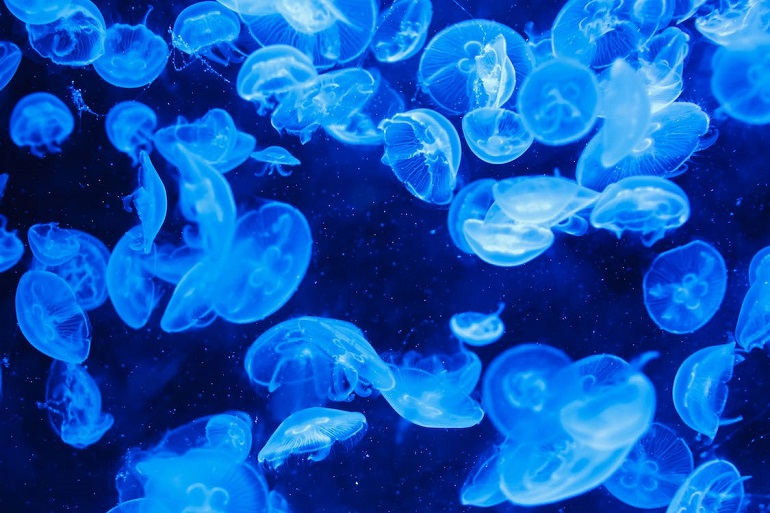
Jellyfish can be seen in most of the world’s oceans, from tropical to coldwater environments, living from surface waters to the deepest ocean.
True jellyfish or Scyphozoan jellyfish are exclusively found in the marine environment. However, some hydrozoans live in freshwater.
Are Jellyfish Endangered?
Although a few species of jellyfish are decreasing, jellyfish populations are actually increasing throughout the oceans.
Jellyfish Are an Important Part of the Ocean Ecosystem
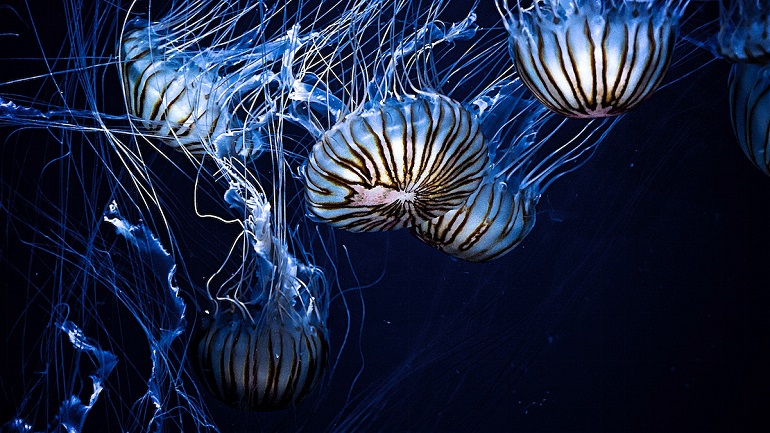
Despite their unassuming appearance, jellies play a vital role in the ocean ecosystem.
These animals are predators and provide an important food source for other animals, such as sea turtles and sharks that eat jellyfish as part of their regular diet.
In addition, jellyfish feed on fish larvae and eggs, helping to control species’ numbers and keeping the ecosystem in balance.
Life Cycle and Behavior
Jellyfish have an extremely complex life cycle. A jelly can reproduce both sexually and asexually throughout its lifetime and has two different physical forms.
Lifecycle and Reproduction
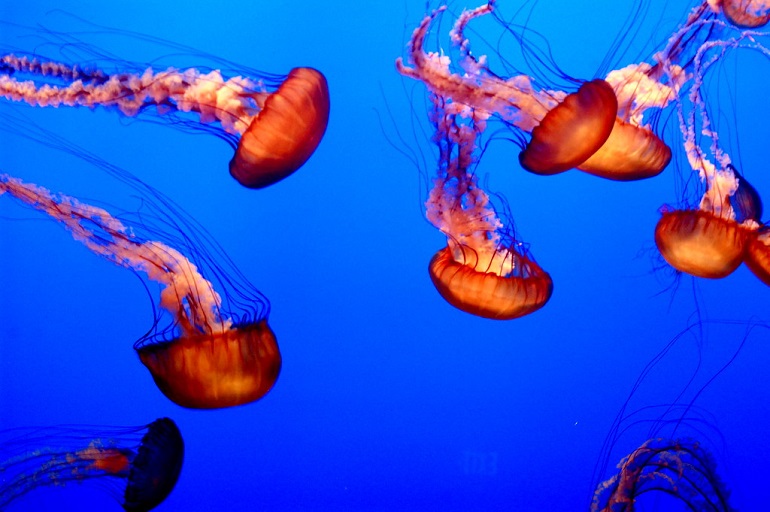
Adult jellies are called medusa, and that’s the familiar umbrella or box-shaped form you see in the water.
Medusa jellyfish produce sexually via mass spawning, where vast amounts of eggs and sperm are released into the open ocean.
Both sexes release eggs and sperm from their mouthparts. Most species fertilize the eggs in the water, whereas in others, the sperm swim into the female jellyfish’s mouth and fertilizes the eggs inside.
The fertilized eggs then develop into planulae. These free-swimming larvae attach to a secure surface after a few days and morph into flower-shaped polyps. These polyps have tentacles and mouths that they use to feed on zooplankton.
Asexual Reproduction
Polyps can reproduce asexually by budding, where the polyp divides to produce a clone.
Alternatively, in some species of jellyfish, the polyp divides into 10 to 15 segments stacked in a “strobila” tower. These segments separate from the tower, becoming ephyrae or juvenile jellyfish, which mature into a medusa form.
Lifespan
Most jellyfish don’t live long. Adult jellyfish typically live for just a few months, although some species have a life expectancy of two to three years.
However, polyps can live and reproduce for a few years or even decades, depending on the species.
Immortal Jellyfish!
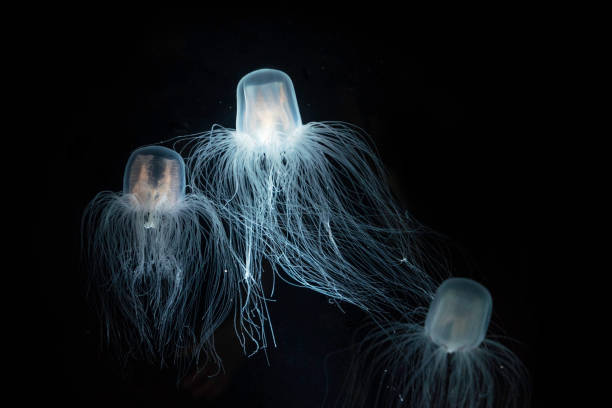
The Turritopsis nutricula jellyfish is virtually immortal. How so?
So, the jellyfish reverts from the adult medusa back to the polyp life stage via a process called transdifferentiation. Turritopsis nutricula is unique, as it’s the only creature known to do that!
Locomotion
The jellyfish swims by contracting the ring of muscles around its bell or dome-shaped body. The bell opens and closes, dragging in the water and forcing it out again to push the jellyfish forward.
Incredible Jellyfish Facts!
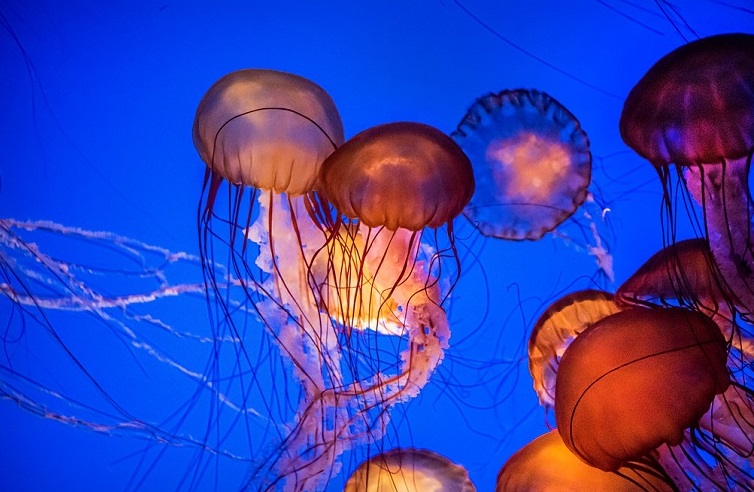
Here are a few amazing jellyfish facts we’re sure you didn’t know!
Jellyfish are Adapting to Climate Change
Where other creatures are faced with extinction, global populations of many jellyfish species have exploded. Huge swarms of jellyfish, known as “blooms,” are now a common sight in most of the planet’s oceans. But why are jellies doing so well?
Recent research shows that the jellyfish population explosion is linked to climate change. As the oceans heat up, jellyfish thrive in the warmer water with less dissolved oxygen, whereas many other species cannot survive in those conditions.
In addition, many of the jellyfish’ natural predators, such as sharks and turtles, are being overfished or killed by pollution.
Jellyfish Have Traveled Into Space!
These amazing creatures have even ventured into space, courtesy of NASA!
In 1991, a single jellyfish went into space aboard the Space Shuttle Discovery to see if the creature could survive without gravity. Remarkably, the animal survived its adventure and returned safely to Earth.
Jellyfish Are Used for Medical Purposes
Jellyfish are sometimes used for medical purposes, for example, to treat bronchitis and blood pressure issues.
Jellyfish Can Be Hunters Or Fishermen
Some jellyfish arrange their tentacles in elaborate spiral patterns to trap their prey. Others simply pull their tentacles along behind them like a trawler’s net as they drift along on the ocean current.
Some Jellyfish Have Teeth
The Beroid comb jellyfish has thousands of tiny teeth made from hairs. The animal uses its teeth to tear, pierce, and drag their prey into their stomachs.
Cell Culture
Jellyfish contain collagen, which scientists use to perform routine cell culture and medical device research.
Ecology of Jellyfish
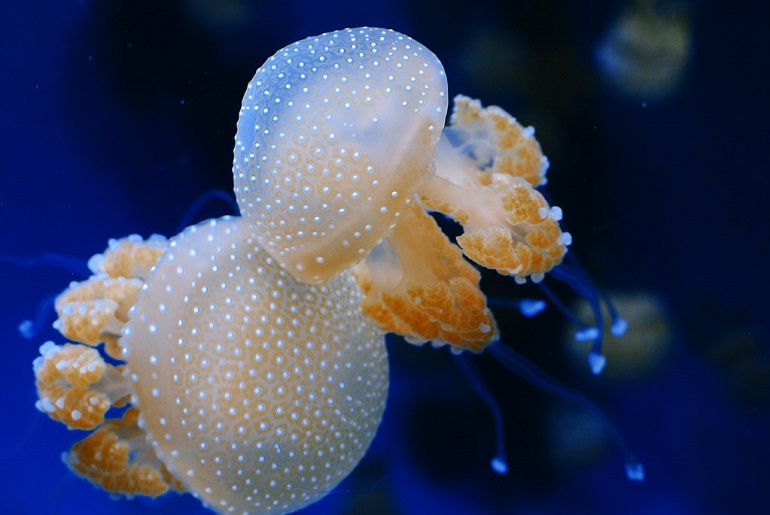
Jellyfish have fascinating relationships with other living creatures in their environment, including humans. In this part of our guide, we look closely at those connections.
Diet
Most jellyfish are carnivorous, although some species occasionally consume plant matter, too.
So, what do jellyfish eat?
Plankton
Most of the jellyfish’s diet is made up of zooplankton, which it catches by floating close to the water’s surface.
Crustaceans
Some of the larger species eat crustaceans, including shrimp, crabs, and even lobsters.
Small Fish
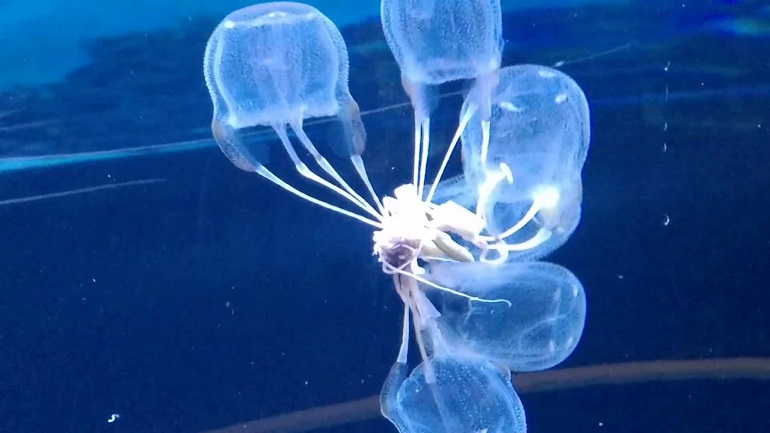
Small fish and fish eggs are another major part of the jellyfish’s diet.
As a child, I remember coming across a large beached jellyfish that had been swept ashore during a winter storm. I was fascinated to see a tiny fish trapped in the center of the jelly, not realizing that the jellyfish must have been feeding when it died.
Fish are an excellent source of protein for jellyfish and contain other essential nutrients for growth and development. When the fish swims into the curtain of trailing tentacles, the jellyfish paralyzes the prey and swallows it whole.
Other Jellyfish!
Although jellyfish don’t contain much nutrition, they do occasionally turn cannibal and eat one of their own.
In these cases, it’s generally an adult jelly eating its offspring or a smaller jelly of a different species.
Symbiosis
The Mastigia jellyfish has a symbiotic relationship with a species of single-celled marine algae called Zooxanthellae.
The jellyfish provides the algae with a home inside the tissues of its frilly arms. In contrast, the algae use solar energy to convert CO2 into carbohydrates that provide the jellyfish with energy.
Parasites
Scientists recently discovered that a species of mucus-like microscopic parasites called Myxozoans is actually a type of degenerated jellyfish.
Myxozoans are a nuisance to commercial fish farmers, attacking fish species such as salmon and trout and causing whirling disease.
Whirling disease costs commercial fisheries hundreds of billions of dollars every year. Who would have believed such a tiny jellyfish could cause that much damage?
Relation to Humans
In addition to being a nuisance to swimmers, jellyfish play a surprisingly large part in human society, both good and bad.
Fisheries

Jellyfish are causing carnage in the Sea of Japan, which is one of the world’s most productive fisheries.
Fishing in Japan is big business; however, over the past decade, the industry has suffered massively from massive annual blooms of the giant jellyfish species, Nemopilema nomurai.
During one of the biggest jellyfish blooms in 2005, between 300 and 500 million jellyfish drifted silently into Japanese fishing waters, causing mayhem.
These enormous jellyfish can reach almost 6 feet across and weigh up to 450 pounds and cause numerous problems for the fishermen.
For example, fishing nets often clog and burst when hauled in full of jellies, and back in 2009, nets bursting with giant jellyfish sank a 10-ton trawler when the fishermen attempted to haul them in.
Products – Jellyfish in Fishing and Cooking
Jellyfish are actively seeded into the oceans in some parts of the world to increase numbers due to the demand in Japan and China for the creatures as a food source.
In Asia, the jellyfish fishing industry is worth hundreds of millions of dollars, providing an essential income for many small coastal towns.
Jellyfish Cuisine
Jellyfish is widely used in Asia as a food source, usually being eaten raw, cooked, hot, or cold.
The creature’s flesh typically reflects the food or seasonings it’s served with. Jellyfish are generally served in strips in salads or served in stir-fry, sushi wraps, or egg rolls. Most people who’ve tried jellyfish say the experience is akin to chewing a rubber band. I’ll pass, thanks!
Biotechnology
Researchers use jellyfish venom, collagen, and other bioactive compounds to develop products that can be utilized in the beauty and medical industries, such as in Chinese medicine.
Aquarium Display
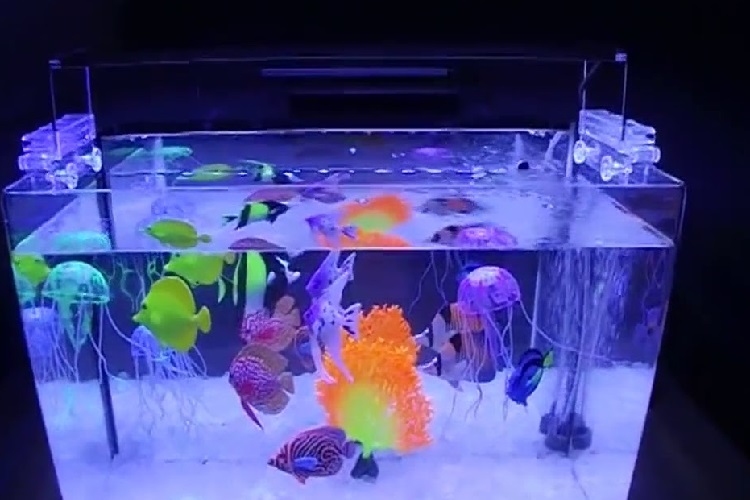
Jellyfish are rapidly becoming popular pets.
However, these creatures are not easy to care for, requiring a specialist aquarium that doesn’t contain corners where the jellies could become trapped, has a constant water flow, and a protected outlet pipe.
These picky creatures need a stable environment, as even the slightest change in temperature can kill them. Sometimes, Moon jellies can become stuck against the tank walls or bottom, so you’ll need to be prepared to move them by wafting water across them gently.
It’s essential to avoid creating air bubbles in the water, as they can become caught in the jellyfish’s bell. If that happens, you’ll need to turn your gelatinous pet upside down and massage it to remove the trapped air!
Fake Jellyfish
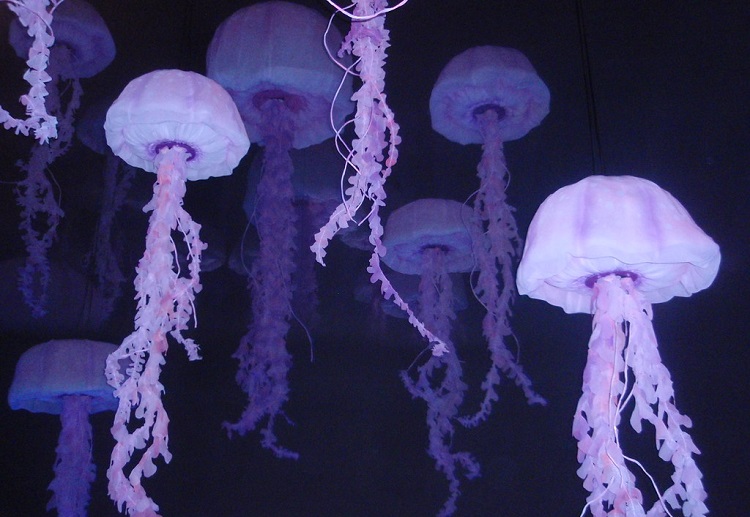
If jellyfish rescue and personal massage sound a tad daunting, you can still enjoy the relaxing vibe that jellies can bring to your room by having a fake jelly tank.
Fake jellyfish are remarkably lifelike but are cheaper to buy and come with no time-consuming maintenance demands. And they don’t die!
FAQ’s
In this section of our jellyfish guide, we answer some of the most commonly asked questions about these primitive creatures.
Do Jellyfish Have Genders?
Most jellyfish can be male or female, although some are hermaphrodites.
What Is a Group of Jellyfish Called?
A group of jellyfish is sometimes referred to as a “smack!” However, the correct term is either a “swarm” or a “bloom.” In the case of box jellyfish, a large group is commonly called a “fluther.”
What Kingdom Do Jellyfish Belong To?
Jellyfish belong to the Animal Kingdom, just like cats, dogs, and you!
How Fast Is a Jellyfish?
Jellyfish can swim at an impressive speed of around 5 miles per hour.
What Are the Differences Between Jellyfish and the Portuguese Man O’ War?
Unlike jellyfish, the Portuguese Man O’ War is a siphonophore. Each Man O’ War is a colony made up of smaller individual organisms whose symbiotic relationship means that they cannot survive alone.
The colony includes a float that keeps the colony at the water’s surface, a raft of flowing, stinging tentacles used for catching prey, a digestive system, and a simple reproductive system.
Final Thoughts
Did you enjoy our guide to jellyfish? If you did, please take a moment to share the article with your friends.
Jellyfish are surprisingly complex yet primitive animals that have been in our oceans for over 700 million years. Most jellies are benign creatures as far as humans are concerned, although the Sea Wasp box jellyfish is one of the most venomous creatures in the ocean and capable of killing a grown human.
Do you have pet jellyfish, or perhaps jellyfish live in the waters close to your home? Tell us about your jelly experiences in the comments box below!


